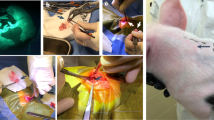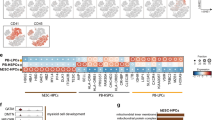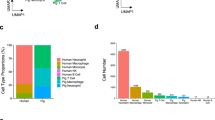Abstract
Existing immunodeficient pig models have demonstrated limited success in supporting robust human haematopoietic engraftment and multilineage differentiation. Here we hypothesize that the targeted deletion of integrin-associated protein (Cd47) in severe combined immunodeficient pigs, with deletions in the X-linked interleukin-2 receptor gamma chain and recombination activating gene 1, would enable long-term haematopoietic engraftment following transplantation with human haematopoietic stem/progenitor cells. In Cd47-deficient pigs, we observed high levels of human haematopoietic chimerism in the blood and spleen, with functional T and B lymphocytes, natural killer and myeloid cells, as well as robust thymopoiesis. Our findings suggest that severe combined immunodeficient pigs with Cd47 deletion represent an improved preclinical model for studying human haematopoiesis, disease mechanisms and therapies, and offer potential as a bioreactor for large-scale production of human immune cells.
This is a preview of subscription content, access via your institution
Access options
Access Nature and 54 other Nature Portfolio journals
Get Nature+, our best-value online-access subscription
$32.99 / 30 days
cancel any time
Subscribe to this journal
Receive 12 digital issues and online access to articles
$119.00 per year
only $9.92 per issue
Buy this article
- Purchase on SpringerLink
- Instant access to full article PDF
Prices may be subject to local taxes which are calculated during checkout






Similar content being viewed by others
Data availability
The main data supporting the results in this study are available within the paper and its Supplementary Information. All raw data generated by scRNA-seq have been deposited to Sequence Read Archive (accession code PRJNA854742; https://www.ncbi.nlm.nih.gov/bioproject/PRJNA854742). Published bone marrow scRNA-seq dataset of healthy adult human donors was downloaded from National Center for Biotechnology Information’s Gene Expression Omnibus (GSE120221). All other data supporting the findings of this study are available from the corresponding authors on reasonable request. Source data are provided with this paper.
Code availability
All data were analysed with standard programmes and packages, as detailed above. Custom code supporting the current study and additional information required to reanalyse the data reported in this paper are available from the GitHub page at https://github.com/kungfu0313/human_HSCT.
References
Larochelle, A. et al. Identification of primitive human hematopoietic cells capable of repopulating NOD/SCID mouse bone marrow: implications for gene therapy. Nat. Med. 2, 1329–1337 (1996).
Lapidot, T. et al. A cell initiating human acute myeloid leukaemia after transplantation into SCID mice. Nature 367, 645–648 (1994).
Barabe, F., Kennedy, J. A., Hope, K. J. & Dick, J. E. Modeling the initiation and progression of human acute leukemia in mice. Science 316, 600–604 (2007).
Traggiai, E. et al. Development of a human adaptive immune system in cord blood cell-transplanted mice. Science 304, 104–107 (2004).
Ishikawa, F. et al. Development of functional human blood and immune systems in NOD/SCID/IL2 receptor {gamma} chain(null) mice. Blood 106, 1565–1573 (2005).
Lan, P. et al. Induction of human T-cell tolerance to porcine xenoantigens through mixed hematopoietic chimerism. Blood 103, 3964–3969 (2004).
Lan, P., Tonomura, N., Shimizu, A., Wang, S. & Yang, Y. G. Reconstitution of a functional human immune system in immunodeficient mice through combined human fetal thymus/liver and CD34+ cell transplantation. Blood 108, 487–492 (2006).
Melkus, M. W. et al. Humanized mice mount specific adaptive and innate immune responses to EBV and TSST-1. Nat. Med. 12, 1316–1322 (2006).
Kumar, P. et al. T cell-specific siRNA delivery suppresses HIV-1 infection in humanized mice. Cell 134, 577–586 (2008).
Tan, S. et al. Type 1 diabetes induction in humanized mice. Proc. Natl Acad. Sci. USA 114, 10954–10959 (2017).
Wahl, A. et al. Precision mouse models with expanded tropism for human pathogens. Nat. Biotechnol. 37, 1163–1173 (2019).
Wang, Y. et al. Exploration of human lung-resident immunity and response to respiratory viral immunization in a humanized mouse model. J. Immunol. 208, 420–428 (2022).
Dick, J. E. Immune-deficient mice as models of normal and leukemic human hematopoiesis. Cancer Cells 3, 39–48 (1991).
Shultz, L. D., Brehm, M. A., Garcia-Martinez, J. V. & Greiner, D. L. Humanized mice for immune system investigation: progress, promise and challenges. Nat. Rev. Immunol. 12, 786–798 (2012).
Rongvaux, A. et al. Human hemato-lymphoid system mice: current use and future potential for medicine. Annu. Rev. Immunol. 31, 635–674 (2013).
Boettcher, A. N., Loving, C. L., Cunnick, J. E. & Tuggle, C. K. Development of severe combined immunodeficient (SCID) pig models for translational cancer modeling: future insights on how humanized SCID pigs can improve preclinical cancer research. Front. Oncol. 8, 559 (2018).
Lunney, J. K. et al. Importance of the pig as a human biomedical model. Sci. Transl. Med. 13, eabd5758 (2021).
Iqbal, M. A., Hong, K., Kim, J. H. & Choi, Y. Severe combined immunodeficiency pig as an emerging animal model for human diseases and regenerative medicines. BMB Rep. 52, 625–634 (2019).
Cooper, D. K., Gollackner, B. & Sachs, D. H. Will the pig solve the transplantation backlog? Annu. Rev. Med. 53, 133–147 (2002).
Yang, Y.-G. & Sykes, M. Xenotransplantation: current status and a perspective on the future. Nat. Rev. Immunol. 7, 519–531 (2007).
Fujiki, Y. et al. Successful multilineage engraftment of human cord blood cells in pigs after in utero transplantation. Transplantation 75, 916–922 (2003).
Itoh, M. et al. Development of an immunodeficient pig model allowing long-term accommodation of artificial human vascular tubes. Nat. Commun. 10, 2244 (2019).
Ozuna, A. G. et al. Preliminary findings of a previously unrecognized porcine primary immunodeficiency disorder. Vet. Pathol. 50, 144–146 (2013).
Suzuki, S. et al. Il2rg gene-targeted severe combined immunodeficiency pigs. Cell Stem Cell 10, 753–758 (2012).
Huang, J. et al. RAG1/2 knockout pigs with severe combined immunodeficiency. J. Immunol. 193, 1496–1503 (2014).
Nochi, T. et al. Elucidation of the effects of a current X-SCID therapy on intestinal lymphoid organogenesis using an in vivo animal model. Cell. Mol. Gastroenterol. Hepatol. 10, 83–100 (2020).
Boettcher, A. N. et al. Human ovarian cancer tumor formation in severe combined immunodeficient (SCID) pigs. Front. Oncol. 9, 9 (2019).
Ren, J. et al. IL2RG-deficient minipigs generated via CRISPR/Cas9 technology support the growth of human melanoma-derived tumours. Cell Prolif. 53, e12863 (2020).
Mishima, K. et al. Development of human hepatocellular carcinoma in X-linked severe combined immunodeficient pigs: an orthotopic xenograft model. PLoS ONE 16, e0248352 (2021).
Lee, K. et al. Engraftment of human iPS cells and allogeneic porcine cells into pigs with inactivated RAG2 and accompanying severe combined immunodeficiency. Proc. Natl Acad. Sci. USA 111, 7260–7265 (2014).
Boettcher, A. N. et al. Novel engraftment and T cell differentiation of human hematopoietic cells in ART−/−IL2RG−/Y SCID pigs. Front. Immunol. 11, 100 (2020).
Oldenborg, P. A. et al. Role of CD47 as a marker of self on red blood cells. Science 288, 2051–2054 (2000).
Wang, H. et al. Lack of CD47 on nonhematopoietic cells induces split macrophage tolerance to CD47null cells. Proc. Natl Acad. Sci. USA 104, 13744–13749 (2007).
Wang, H. et al. Attenuation of phagocytosis of xenogeneic cells by manipulating CD47. Blood 109, 836–842 (2007).
Lavender, K. J. et al. BLT-humanized C57BL/6 Rag2−/−γc−/−CD47−/− mice are resistant to GVHD and develop B- and T-cell immunity to HIV infection. Blood 122, 4013–4020 (2013).
Takenaka, K. et al. Polymorphism in Sirpa modulates engraftment of human hematopoietic stem cells. Nat. Immunol. 8, 1313–1323 (2007).
Boettcher, A. N. et al. Porcine signal regulatory protein alpha binds to human CD47 to inhibit phagocytosis: implications for human hematopoietic stem cell transplantation into severe combined immunodeficient pigs. Xenotransplantation 26, e12466 (2019).
Abe, M. et al. Elimination of porcine hemopoietic cells by macrophages in mice. J. Immunol. 168, 621–628 (2002).
Watanabe, H. et al. Intra-bone bone marrow transplantation from hCD47 transgenic pigs to baboons prolongs chimerism to >60 days and promotes increased porcine lung transplant survival. Xenotransplantation 27, e12552 (2020).
Huntington, N. D. et al. IL-15 trans-presentation promotes human NK cell development and differentiation in vivo. J. Exp. Med. 206, 25–34 (2009).
Chen, Q., Khoury, M. & Chen, J. Expression of human cytokines dramatically improves reconstitution of specific human-blood lineage cells in humanized mice. Proc. Natl Acad. Sci. USA 106, 21783–21788 (2009).
Rongvaux, A. et al. Development and function of human innate immune cells in a humanized mouse model. Nat. Biotechnol. 32, 364–372 (2014).
Oetjen, K. A. et al. Human bone marrow assessment by single-cell RNA sequencing, mass cytometry, and flow cytometry. JCI Insight 3, e124928 (2018).
Yahata, T. et al. Functional human T lymphocyte development from cord blood CD34+ cells in nonobese diabetic/Shi-scid, IL-2 receptor γ null mice. J. Immunol. 169, 204–209 (2002).
Legrand, N., Weijer, K. & Spits, H. Experimental models to study development and function of the human immune system in vivo. J. Immunol. 176, 2053–2058 (2006).
Danner, R. et al. Expression of HLA class II molecules in humanized NOD.Rag1KO.IL2RgcKO mice is critical for development and function of human T and B cells. PLoS ONE 6, e19826 (2011).
Suzuki, M. et al. Induction of human humoral immune responses in a novel HLA-DR-expressing transgenic NOD/Shi-scid/gcnull mouse. Int. Immunol. 24, 243–252 (2012).
Habiro, K., Sykes, M. & Yang, Y. G. Induction of human T-cell tolerance to pig xenoantigens via thymus transplantation in mice with an established human immune system. Am J Transplant 9, 1324–1329 (2009).
Kalscheuer, H. et al. Xenograft tolerance and immune function of human T cells developing in pig thymus xenografts. J. Immunol. 192, 3442–3450 (2014).
Park, J. E. et al. A cell atlas of human thymic development defines T cell repertoire formation. Science 367, eaay3224 (2020).
Carico, Z. M., Roy Choudhury, K., Zhang, B., Zhuang, Y. & Krangel, M. S. Tcrd rearrangement redirects a processive Tcra recombination program to expand the Tcra repertoire. Cell Rep. 19, 2157–2173 (2017).
Nauman, G. et al. Reduced positive selection of a human TCR in a swine thymus using a humanized mouse model for xenotolerance induction. Xenotransplantation 27, e12558 (2020).
Tee, B. C. & Sun, Z. Mandibular distraction osteogenesis assisted by cell-based tissue engineering: a systematic review. Orthod. Craniofac. Res. 18, 39–49 (2015).
Guillon, A. et al. Intra-tracheal amikacin spray delivery in healthy mechanically ventilated piglets. Pulm. Pharmacol. Ther. 57, 101807 (2019).
Taha, A. et al. Comparison of large animal models for acute ischemic stroke: which model to use? Stroke 53, 1411–1422 (2022).
Tasaki, M. et al. High incidence of xenogenic bone marrow engraftment in pig-to-baboon intra-bone bone marrow transplantation. Am. J. Transplant. 15, 974–983 (2015).
Jin, C. H. et al. Modeling anti-CD19 CAR T cell therapy in humanized mice with human immunity and autologous leukemia. eBioMedicine 39, 173–181 (2019).
Hao, Y. et al. Integrated analysis of multimodal single-cell data. Cell 184, 3573–3587.e3529 (2021).
R Core Team. R: a language and environment for statistical computing. https://www.R-project.org/ (R Foundation for Statistical Computing, 2021).
Aran, D. et al. Reference-based analysis of lung single-cell sequencing reveals a transitional profibrotic macrophage. Nat. Immunol. 20, 163–172 (2019).
Mabbott, N. A., Baillie, J. K., Brown, H., Freeman, T. C. & Hume, D. A. An expression atlas of human primary cells: inference of gene function from coexpression networks. BMC Genom. 14, 632 (2013).
Schmiedel, B. J. et al. Impact of genetic polymorphisms on human immune cell gene expression. Cell 175, 1701–1715.e1716 (2018).
Novershtern, N. et al. Densely interconnected transcriptional circuits control cell states in human hematopoiesis. Cell 144, 296–309 (2011).
Monaco, G. et al. RNA-seq signatures normalized by mRNA abundance allow absolute deconvolution of human immune cell types. Cell Rep. 26, 1627–1640.e1627 (2019).
Li, C. et al. SciBet as a portable and fast single cell type identifier. Nat. Commun. 11, 1818 (2020).
Korsunsky, I. et al. Fast, sensitive and accurate integration of single-cell data with Harmony. Nat. Methods 16, 1289–1296 (2019).
Kolde, R. pheatmap: Pretty Heatmaps. R package version 1.0.12. https://CRAN.R-project.org/package=pheatmap (2019).
Acknowledgements
This work was supported by grants from Chinese MOST (2021YFA1100700), the Strategic Priority Research Program of the Chinese Academy of Sciences (XDA16030000), Chinese MOST (2017YFA0104400) and NSFC (82241224, W2441022 and 81941008).
Author information
Authors and Affiliations
Contributions
Z. Hu, J.Z., P.A., Y.L., R.S., L. Su, H.Z., Q.D., H.T., T.S., L. Sun, C.S. and J.H. performed the experiment. Z.W., K.X., T.H., S.Z., D.Y., J.R., Z. Han, C.L., J.W., Q.W., X.D., X.A. and Y.Z. contributed to the generation of immunodeficient pig. C.F. and S.D. contributed to scRNA-seq data analysis. Y.-G.Y., Z. Hu and J.Z. analysed the data. Y.-G.Y. and Z. Hu wrote the paper. Q.Z., W.L. and Z.L. edited the paper. Z. Hu, Y.-G.Y., Q.Z., W.L. and Z.L. conceived and designed the study.
Corresponding authors
Ethics declarations
Competing interests
The authors declare no competing interests.
Peer review
Peer review information
Nature Biomedical Engineering thanks Yutaka Hanazono, Christopher Tuggle and the other, anonymous, reviewer(s) for their contribution to the peer review of this work. Peer reviewer reports are available.
Additional information
Publisher’s note Springer Nature remains neutral with regard to jurisdictional claims in published maps and institutional affiliations.
Extended data
Extended Data Fig. 1 Lack of cross reaction between Bama pig SIRPα and human CD47 and rejection of human cells by Bama pig macrophages in vivo.
(a) Biotin conjugated human CD47-fc was incubated with human or Bama pig PBMCs followed by streptavidin-PE staining and examined by flow cytometry. The controls were stained with streptavidin-PE alone. Shown are representative profiles showing hCD47-fc staining of SSChigh monocytes/macrophages. (b, c) Human and pig RBCs were labeled with high or low intensity of CFSE respectively, mixed at 1:1 ratio and intravenously injected into Bama pigs that were pre-treated with GdCl3 to deplete macrophages (n = 1) or saline (as control; n = 1). Flow cytometric profiles (b) and levels (%; c) of human RBCs (CFSEhi) in total surviving CFSE+ cells are shown.
Extended Data Fig. 2 Two representative photos of immunodeficient pigs.
Photos of a RG pig taken at age of 213 days (a) and a RGD pig taken at age of 217 days (b).
Extended Data Fig. 3 Human chimerism in NSG mice receiving BM cells from a human CD34+ cell-transplanted RG pig.
BMCs were harvested from RG#002 pig and intravenously injected into two NSG mice that were treated with 20 mg/kg busulfan one day ahead. These mice were euthanized 18 weeks after transplantation and analyzed by flow cytometry for human lymphohematopoietic cells in PBMCs, spleen (SPL), thymus (THY) and BM. Human cells were detected in these tissues from both animals and staining profiles of one mouse are shown.
Extended Data Fig. 4 Phenotypic analysis of human myeloid cells and thymocytes in RGD#007 pig.
The cells were harvested from RGD#007 pig at day 204. (a) Flow cytometric profiles of human CD14+ monocytes, CD11c+CD123− myeloid dendritic cells, CD11c−CD123+ plasmacytoid dendritic cells were shown. CL: CD16− classical monocyte; ITM: CD16+ intermedium monocyte; NC: CD16++ non-classical monocytes. Human PBMCs were used as positive control. (b) Expression of human CD3 in human thymocytes.
Extended Data Fig. 5 Histological analysis of RGD pig spleen after human CD34+ cell transplantation.
(a) H&E staining of spleen sections from WT Bama pig (left), and RGD pigs without (middle) or with human CD34+ cell transplantation (RGD#007; right). W, white pulp region (indicated by yellow line); R, red pulp region. (b) Representative immunohistochemical staining for human CD45+ cells, CD4+ T cells, CD20+ B cells, and CD11c+ DCs in splenic sections of the RGD#007 pig.
Extended Data Fig. 6 Anatomical images of RGD pig thymus with or without human CD34+ cell transplantation.
Photos of the pig thymi collected from a control RGD pig (a) without human CD34+ cell transplantation at day 25 after birth, and human CD34+ cell transplanted RGD#001 (b) and RGD#007 (c) pigs after euthanasia. Yellow dash line indicates the anatomical location of the pig thymus.
Extended Data Fig. 7 Human T cell phenotype analysis.
Shown are flow cytometric profiles of human CD4 and CD8 T cells in RGD#001 (a) and RGD#007 (b) pig PBMCs at day 114 and day 204, respectively.
Extended Data Fig. 8 TCR V(D)J gene segment recombination analysis in human thymocytes.
Shown are TCR segment recombination profiles of human CD45+ thymocytes collected from RGD#001 (a, b) and RGD#007 (c, d) pigs respectively. (a, c) Relative frequency (log scale) of V-J, V-D, J-D gene pairs in TCRβ locus of human thymocytes. (b, d) Relative frequency (log scale) of V-J gene pairs in TCRɑ locus of human thymic SP cells.
Extended Data Fig. 9 Human BCR V(D)J gene segment recombination analysis in RGD pig BM cells.
Human CD45+ cells were collected from RGD#001 (a–c) and RGD#007 (d–f) pig BM. (a, d) Relative frequency (log scale) of V-J, D-J, V-D gene pairs in IgH locus. (b, c and e, f) Relative frequency (log scale) of V-J gene pairs in immunoglobulin κ (b) and λ (c) chain loci.
Supplementary information
Source data
Source Data Figs. 3b–d and 6b,d
Source data.
Rights and permissions
Springer Nature or its licensor (e.g. a society or other partner) holds exclusive rights to this article under a publishing agreement with the author(s) or other rightsholder(s); author self-archiving of the accepted manuscript version of this article is solely governed by the terms of such publishing agreement and applicable law.
About this article
Cite this article
Hu, Z., Zou, J., Wang, Z. et al. Long-term engraftment of human stem and progenitor cells for large-scale production of functional immune cells in engineered pigs. Nat. Biomed. Eng (2025). https://doi.org/10.1038/s41551-025-01397-6
Received:
Accepted:
Published:
DOI: https://doi.org/10.1038/s41551-025-01397-6
This article is cited by
-
A pig with functional human immunity
Nature Biomedical Engineering (2025)



